How to Cite | Publication History | PlumX Article Matrix
Lichen Floristic Study from Southeast of Ilam Province (Iran) (Dehloran, Abdanan, Darehshahr)
Simin Younesi*, Taher Nejadsattari, Rahele Hasani
Department of Biology, Faculty of Sciences, Science and Research Branch, Islamic Azad University, Tehran, Iran.
ABSTRACT: Ilam province is located between 45◦ 24' to 48◦ 10' Eastern longitude and 31◦ 58' to 34◦ 15' northern latitude (west of Iran). Persian Gulf withdrawal in quaternary period caused to the development of alluvial plains that can be seen in West, South and Southwest areas of Ilam. Lichens from Kabirkooh and Dynarkooh Mountain, Dehloran and Mosian plain and Iran-Iraq border were collected during 2007 and 2008. All collected samples were recognized based on the morphology, chemistry and by use of identification keys. Among 300 collected samples, 14 genera and 25 species were introduced. Most of them are Saxicolous, Terricolous, Lignicolous and Lichenicolous and two genera of the Chrysothricaceae Collemataceae family were reported from Iran for the first time.
KEYWORDS: lichens; morphology; chemical testing; Floristic Study; Iran
Download this article as:| Copy the following to cite this article: Younesi S, Nejadsattari T, Hasani R. Lichen Floristic Study from Southeast of Ilam Province (Iran) (Dehloran, Abdanan, Darehshahr). Biosci Biotech Res Asia 2015;12(2) |
Introduction
Based on evidence the emergence of lichens as composite organisms date back to over four hundred million years ago (Devonian). Lichens are composed of a fungus and a photosynthetic partner (green algae «Chlorophyceae», green-blue «Cyanophyceae» algae or both of them) growing together in a reciprocal arrangement and symbiotic form. The fungus in this collection are called «Mycobiont», most of them are Ascomycetes and a few are Basidiomycetes. Algae in this collection are called «Phycobiont». Lichens have different vegetative forms such as Crastose, Foliose, Fraticose, Gelatinous and Squamulose which give particular forms to lichens’ structure. On the other hand, lichens are highly regarded and used in medicine, pharmaceuticals, paint industries, perfume making, production of vitamins and air pollution indicators [1-7].
There are some case studies about lichens in Iran. The study of lichens in Iran refers to 1885 when Stapf studied some parts of Fars province. Muller (1892) conducted some studies on the lichens of Fars and Isfahan. In recent years, some studies has also been done by Massumi, Sohrabi, Haji Munir, Valad-Beigi, Dianat Nezhad, Kraam Dini, Zare Hassan Abadi and Abedi [8-13]. Due to the highly different climate and geographical conditions in the study areas as well as the lack of a checklist of lichens, this study have been focused on lichens.
Materials and Methods
The study area
Ilam province is located between 45◦ 24′ to 48◦ 10′ Eastern longitude and 31◦ 58′ to 34◦ 15′ northern latitude. Dehloran city, in terms of topography, is divided into two distinct areas, mountains, foothills and plains and hill that low-altitude mountains are located at the Dehloran border region with Iraq.
Dehloran
Dehloran which altitude from sea level is about 232 meters, is located at the southern region of Ilam province with hot and dry climate especially in summers, similar to Khozestan and high evaporation rate about 10 times more than rainfall per year. Maximum and minimum temperature reach to 51 and 2 degrees Celsius in July and January, respectively. Average rainfall in this region is 250-270 mm and average annual evaporation is 2841 mm. The average relative humidity, during a year, is about 36% [14, 15].
Dareshahr
Like as narrow strip, Dareshahr is located between Kabirkooh Mountain and Seymare River in Zagros Mountains stretching along the north-west to south-east with about 1,435 square kilometers (length of 160 km and width of 9 km). It is situated close to the ruins of the ancient city, Seymare (or Madakto), with a distance of 4 km from the Seymare River in a wide valley on the northern slopes of Kabirkooh (Zagros Mountains) to Ilam and a distance of 170 km from Khoram Abad, between 47◦ 24′ northern latitude and 33◦ 9′ Eastern longitude. 1150 meters is recorded as its height from sea level [14, 15].
Kabirkooh
This mountain starts from near the southern part of Ilam (Aftab Col), continues until the Karkheh River where the land becomes flat with a length of 160 km. The highest point, Kahn Saifi, is in a place called Varzarin. As the largest and most systematic Mountain of Ilam, it is the source of many rivers. A part of it surrounds the northern region of Dehloran city [14, 15].
Dinarkooh
Dinarkooh Mountains is located in the north of Dehloran between Abdanan and Dehloran, with approximately 2600 meters above sea level. In the West and Southwest regions of Ilam, there are some mountain such as Koolak, Nakhjir, Deshmin and Anaraan [14, 15].
Ilam border region with Iraq
Low mountains of Hamrain are located in Ilam border region with Iraq, stretching from Mehran (Bahram Abad) to Khozestan were emerged during Tertiary orogenic movements as a result of the collision between the Arabian plate and Iran Central plate in North West-South East direction. Sediments during the second to fourth geological period have formed these mountains being affected by erosion in the Quaternary period [14, 15].
Samplin
From about 30 different trips to the different parts from the southeastern of Ilam province (Iran), more than 300 samples of lichens were collected. In order to collect lichens’ samples, the 1:1000 map of area was initially prepared, then the samples were collected using masonry pen, hammer, knife and screwdriver. Sampling regions are shown in Figure 1 as written here:
Iran, Ilam province, Dehloran district, Havar, 32.886263 N, 046.915924 E.
Iran, Ilam province, Dehloran district, Park Taleghani, 32.499771 N, 47.48326 E.
Iran, Ilam province, Dehloran district, Abegarm, 32.695473 N, 47.316596 E.
Iran, Ilam province, Dehloran district, near international boundary, 32,836796 N, 46.868362 E.
Iran, Ilam province, Dehloran district, Gosalo (near shahrake Hejrat), 32.690107 N, 047.412421 E.
Iran, Ilam province, Darehshahr district, Sarabe kolm, 33.341065 N, 046.902159 E.
Iran, Ilam province, Darehshahr district, Kolme bala, 33.357055 N, 06.90292 E.
Iran, Ilam province, Abdanan district, Kabir Kouh, Vargar, 32.956093 N, 047.406706 E.
Iran, Ilam province, Abdanan district, Kabir Kouh, North of Vargar, 32.947379 N, 47.370533 E.
Iran, Ilam province, Abdanan district, Kabir Kouh (near Microwave), 33.069393 N, 47.324857 E.
Iran, Ilam province, Abdanan district, Dinar Kouh, Radar (North of Vargar), 32.936672 N, 047.33841 E.
Iran, Ilam province, Abdanan district, Dinar Kouh, ChameKabud, 32.922202 N, 047.512805 E.
Iran, Ilam province, Abdanan district, Dinar Kouh, Shalat, 32.802708 N, 047.554702 E.
Iran, Ilam province, Abdanan district, Near Murmuri, 32.724587 N, 047.659362 E.
Iran, Ilam province, Abdanan district, Near Murmuri, Panj barar, 32,775193 N, 47.640601 E.
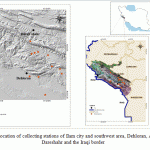 |
Figure 1: Location of collecting stations of Ilam city and southwest area, Dehloran, Abdanan, Dareshahr and the Iraqi border |
Samples were stored in small cans or paper bag with the date and place. And the data for each sample were recorded under a specific code in a form. The histological structure of samples was examined using evaluation methods and Microscopic studies. For this purpose, the samples were molded, after fixation in FAA and dehydrated through ascending grades of alcohol and toluene and paraffin. Then they are cut by microtome and removing the paraffin by xylem through the ascending grades of alcohol by Cotton Blue – Erythrosine, Double staining was done. The macroscopic studies were also conducted to identify each species. Attributes that were used to identification includes, Tal colors and different shapes of thallus (shells, leaves, shrubs, squamous), Apothecium condition (uniform, non-uniform, spherical cup), presence or absence of hymnum layer in perithecia and Apothecium, the study of algae, spores features (color, size, or absence of wall and the number in each ascus bag), and finally by chemical tests [2, 16, 17]. And lichens were identified according to the sources and identification keys such as Hale 1979, Krog 1980, Moberg 1977, Hafellner 1979, Thomson 1984, Purvis et al 1992, Elix 1993, Mccune 1995, McCune, B. 2010, Gaward et al. 1996, Dobson 2000, Sipman 2003 and etc. [1, 4, 17-30].
Results and Discussion
In this study, 14 genera and 25 species of lichens were collected from the mountains and plains of Abdanan, Dehloran, Dareshahr and the Iraqi border (Ilam province, Iran) (Table 1) (Figure 2-25).
Among the identified species, two species recorded for Iran include:
- Chrysothrix xanthina (Vainio), Kalb. (Iran, Ilam province,Darehshahr district, Sarabe kolm, 2008.3.28)
- Leptogium laceroides (B. de Lesd.) P.M. Jørg. (Iran, Ilam province, Abdanan district, Dinar Kouh, ChameKabud 2008.3.12)
And five species recorded for Ilam Province consist:
- Fulgensia fulgida (NYL.) Szat
- Glypholecia scabra (pers.) Mull
- Psora crenata (Taylor) Reinke
- Psora vallesiaca (Schaerer) Timdal
T.lutosa (Ach.) Timda
Table 1: Lichen species in the southeastern region of Ilam province (Iran)
| Species | Genera | Family | |
| Acarospora cervina (Pers in Ach)
A. Stigata (NYL.)Jatta Glypholecia scabra (Pers) |
Acarospora (Massal)
Glypholecia NYL |
Acarosporaceae | 1 |
| Squamarina lentigera (Weber) Poelt | Squamarina poelt | Bacidiaceae | 2 |
| Toninia diffracta (missal) Zahlbr
T. lutosa (Ach.) Timdal T. sedifolia (Scop.) Timdal |
Toninia (Massal) | Catillariaceae | 3 |
| Collema cristatum (L) Weber
C. flaccidium (Ach.) Ach C. tenax (SW.) Ach L. laceroides (B. de Lesd.) P.M. Jørg |
Collema weber
Leptogium |
Collemataceae | 4 |
| Chrysothrix xanthina ( Vainio), Kalb | Chrysothrix | Chrysothricaceae | 5 |
| Lecanora muralis (Schreber)
Rhizoplaca melanophtalma (Ramond) R. peltata (Ramond) Leuckert |
Lecanora (Ach).
Rhizoplaca Zopf |
Lecanoraceae | 6 |
| Opegrapha herbarum (Mont) James | Opegrapha (Stizenb) | Opegraphaceae | 7 |
| Placidium semaforonense (Breuss)
P. squamulosum (Ach.) Breuss |
Placidium | Verrucariaceae | 8 |
| Psora crenata (Taylor) Reinke
Psora decipiens (Hedw.) Hoffm P. vallesiaca (Schaerer)Timdals |
Psora Hoffm | Psoraceae | 9 |
| Fulgensia fulgida (NYL)Szat,
F. subbracteat (NYL).Poelt F. fulgens (Swartz) Elenkin Xanthoria parietina (L)Th.Fr. |
Fulgensia Massal
Xanthoria (Fr.) Th.Fr. |
Teloschistaceae | 10 |
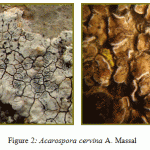 |
Figure 2: Acarospora cervina A. Massal |
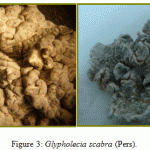 |
Figure 3: Glypholecia scabra (Pers) |
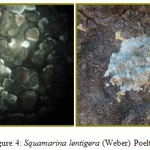 |
Figure 4: Squamarina lentigera (Weber) Poelt |
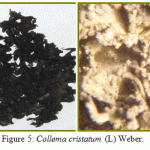 |
Figure 5: Collema cristatum (L) Weber |
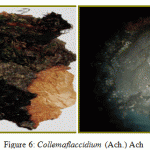 |
Figure 6: Collemaflaccidium (Ach.) Ach |
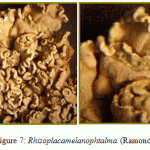 |
Figure 7: Rhizoplacamelanophtalma (Ramond) |
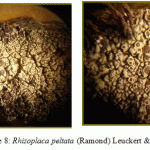 |
Figure 8: Rhizoplaca peltata (Ramond) Leuckert & poelt |
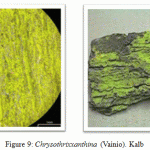 |
Figure 9: Chrysothrixxanthina (Vainio). Kalb |
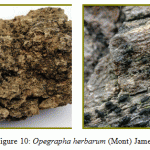 |
Figure 10: Opegrapha herbarum (Mont) James |
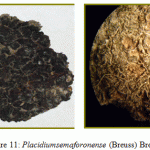 |
Figure 11: Placidiumsemaforonense (Breuss) Breuss |
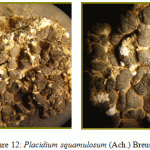 |
Figure 12: Placidium squamulosum (Ach.) Breuss |
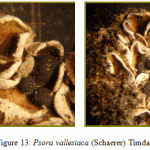 |
Figure 13: Psora vallesiaca (Schaerer) Timdal |
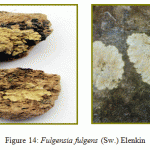 |
Figure 14: Fulgensia fulgens (Sw.) Elenkin |
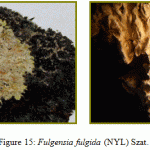 |
Figure 15: Fulgensia fulgida (NYL) Szat |
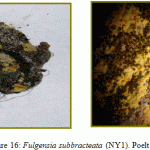 |
Figure 16: Fulgensia subbracteata (NY1). Poelt |
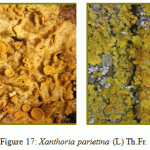 |
Figure 17: Xanthoria parietina (L) Th.Fr |
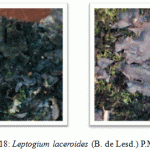 |
Figure 18: Leptogium laceroides (B. de Lesd.) P.M. Jørg |
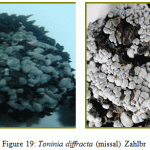 |
Figure 19: Toninia diffracta (missal) Zahlbr |
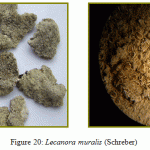 |
Figure 20: Lecanora muralis (Schreber) |
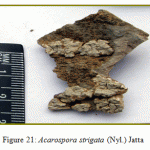 |
Figure 21: Acarospora strigata (Nyl.) Jatta |
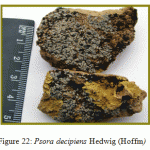 |
Figure 22: Psora decipiens Hedwig (Hoffm) |
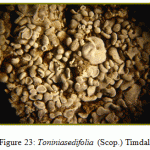 |
Figure 23: Toniniasedifolia (Scop.) Timdal |
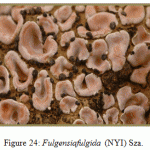 |
Figure 24: Fulgensiafulgida (NYI) Sza |
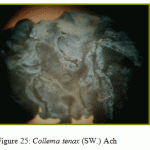 |
Figure 25: Collema tenax (SW.) Ach |
References
- Ahmadjian, V. and M.E. Hale, The lichens1973: Academic Press.
- Ahmadjian, V., A guide for the identification of algae occurring as lichen symbionts1958.
- Asahina, Y. and S. Shibata, Chemistry of lichen substances. 1954.
- Hale, M.E., How to know the lichens. The pictured-key nature series. WM. C, 1979, Brown Company Publishers, Dubuque.[Links].
- Hawksworth, D.L. and F. Rose, Lichens as air pollution monitors. Studies in biology, 1976. 66.
- Din, L.B., et al., Chemical profile of compounds from lichens of Bukit Larut, Peninsular Malaysia. Sains Malaysiana, 2010. 39(6): p. 901-908.
- Johnson, G.T., Ascogonia and spermatia of Stereocaulon. Mycologia, 1954: p. 339-345.
- Valadbeigi T., collection and identification of underwater moss region ( Mazandaran), 2004, University of Shahid Beheshti.
- Sohrabi, M. and M. Jamshidikia, Two species of Flavopunctelia new to the lichenized mycota of Iran. Iranian Journal of Botany, 2007. 13(1): p. 4-5.
- M., H.M., Identifying lichens of Khorasan province, 2004, Islamic Azad University, Science and Research Branch.
- Abedi , F., Lichen ecosystematic of Saxicolous lichens in northeast mountains of Mashhad, distance between Marshk and Asheq Dare, 1997 Ferdowsi University of Mashhad.
- Zari Hassan Abadi, M., the study and introducing of Saxicolous lichens,, 2002, Faculty of Sciences, Ferdowsi University of Mashhad.
- Dianat Nezhad, H. and M. Krum Din, Lichens reef ecosystems of northern Tehran Heights,, 1991, Islamic Azad University, North Branch.
- R., J., Agricultural development in the city Dehloran, , 2003, University of malayer.
- I., A.S., Ilam and its ancient civilization1990.
- Ahmadjian, V., The lichen symbiosis1993: John Wiley & Sons.
- Moberg, R., The lichen genus Physcia and allied genera in Fennoscandia. 1977.
- Hawksworth, D., Conidiomata, conidiogenesis, and conidia. CRC Handbook of lichenology, 1988. 1: p. 181-193.
- Hooper, J., et al., The chemistry of fungi. Part LXV. The structures of ergochrysin A, isoergochrysin A, and ergoxanthin, and of secalonic acids A, B, C, and D. Journal of the Chemical Society C: Organic, 1971: p. 3580-3590.
- D., J., Lichens and podogenesis, Handbook of Lichenology. Vol. 30. 1988: Handbook of Lichenology.
- Magnusson, A.H., A monograph of the genus Acarospora. Vol. 6. 1929: Almqvist & Wiksells Boktryckeri.
- Nicholson, B.E. and F.H. BRIGHTMAN, The Oxford book of flowerless plants. The Oxford book of flowerless plants., 1979.
- Krog, H., H. 0sthagen, and T. Tonsberg, Lavflora. Norske busk-og bladlav, 1980.
- Purvis, O., Lichen Flora of Great Britain and Ireland. 1992.
- H., S. Lichen determination keys, Lichen genera of Iran. 2003; Available from: http://www.bgbm.org/Sipman/Keys/Irangenera.htm.
- Hafellner, J., Karschia. 1979.
- Thomson, J.W., American Arctic Lichens: The microlichens. Vol. 2. 1984: Univ of Wisconsin Press.
- Elix, J.A., Progress in the generic delimitation of Parmelia sensu lato lichens (Ascomycotina: Parmeliaceae) and a synoptic key to the Parmeliaceae. Bryologist, 1993: p. 359-383.
- McCune, B. and T. Goward, Macrolichens of the northern Rocky Mountains1995: Mad River Pr Inc.
- Dobson, F., Lichens. An Illustrated Guide to the British and Irish Species,. Richmond, Slough, 2000.

This work is licensed under a Creative Commons Attribution 4.0 International License.





